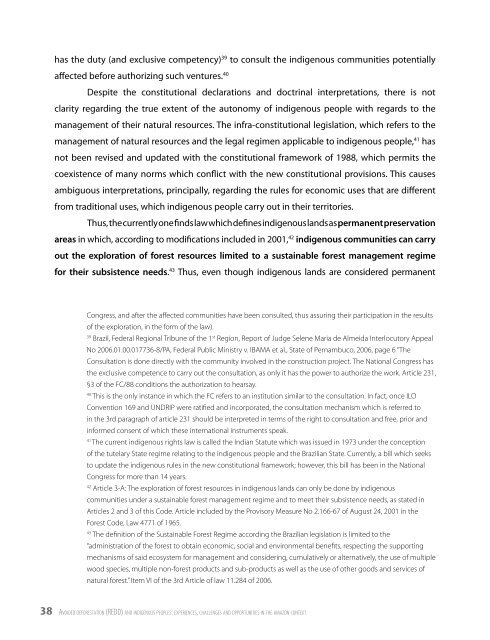Avoided Deforestation (REDD) and Indigenous ... - Amazon Fund
Avoided Deforestation (REDD) and Indigenous ... - Amazon Fund
Avoided Deforestation (REDD) and Indigenous ... - Amazon Fund
You also want an ePaper? Increase the reach of your titles
YUMPU automatically turns print PDFs into web optimized ePapers that Google loves.
has the duty (<strong>and</strong> exclusive competency) 39 to consult the indigenous communities potentially<br />
affected before authorizing such ventures. 40<br />
Despite the constitutional declarations <strong>and</strong> doctrinal interpretations, there is not<br />
clarity regarding the true extent of the autonomy of indigenous people with regards to the<br />
management of their natural resources. The infra-constitutional legislation, which refers to the<br />
management of natural resources <strong>and</strong> the legal regimen applicable to indigenous people, 41 has<br />
not been revised <strong>and</strong> updated with the constitutional framework of 1988, which permits the<br />
coexistence of many norms which conflict with the new constitutional provisions. This causes<br />
ambiguous interpretations, principally, regarding the rules for economic uses that are different<br />
from traditional uses, which indigenous people carry out in their territories.<br />
Thus, the currently one finds law which defines indigenous l<strong>and</strong>s as permanent preservation<br />
areas in which, according to modifications included in 2001, 42 indigenous communities can carry<br />
out the exploration of forest resources limited to a sustainable forest management regime<br />
for their subsistence needs. 43 Thus, even though indigenous l<strong>and</strong>s are considered permanent<br />
Congress, <strong>and</strong> after the affected communities have been consulted, thus assuring their participation in the results<br />
of the exploration, in the form of the law).<br />
39 st Brazil, Federal Regional Tribune of the 1 Region, Report of Judge Selene Maria de Almeida Interlocutory Appeal<br />
No 2006.01.00.017736-8/PA, Federal Public Ministry v. IBAMA et al., State of Pernambuco, 2006, page 6 “The<br />
Consultation is done directly with the community involved in the construction project. The National Congress has<br />
the exclusive competence to carry out the consultation, as only it has the power to authorize the work. Article 231,<br />
§3 of the FC/88 conditions the authorization to hearsay.<br />
40 This is the only instance in which the FC refers to an institution similar to the consultation. In fact, once ILO<br />
Convention 169 <strong>and</strong> UNDRIP were ratified <strong>and</strong> incorporated, the consultation mechanism which is referred to<br />
in the 3rd paragraph of article 231 should be interpreted in terms of the right to consultation <strong>and</strong> free, prior <strong>and</strong><br />
informed consent of which these international instruments speak.<br />
41 The current indigenous rights law is called the Indian Statute which was issued in 1973 under the conception<br />
of the tutelary State regime relating to the indigenous people <strong>and</strong> the Brazilian State. Currently, a bill which seeks<br />
to update the indigenous rules in the new constitutional framework; however, this bill has been in the National<br />
Congress for more than 14 years.<br />
42 Article 3-A: The exploration of forest resources in indigenous l<strong>and</strong>s can only be done by indigenous<br />
communities under a sustainable forest management regime <strong>and</strong> to meet their subsistence needs, as stated in<br />
Articles 2 <strong>and</strong> 3 of this Code. Article included by the Provisory Measure No 2.166-67 of August 24, 2001 in the<br />
Forest Code, Law 4771 of 1965.<br />
43 The definition of the Sustainable Forest Regime according the Brazilian legislation is limited to the<br />
“administration of the forest to obtain economic, social <strong>and</strong> environmental benefits, respecting the supporting<br />
mechanisms of said ecosystem for management <strong>and</strong> considering, cumulatively or alternatively, the use of multiple<br />
wood species, multiple non-forest products <strong>and</strong> sub-products as well as the use of other goods <strong>and</strong> services of<br />
natural forest.” Item VI of the 3rd Article of law 11.284 of 2006.<br />
38 Av o i d e d d e f o re s t A t i o n (redd) A n d i n d i g e n o u s p e o p l e s: experiences, chAllenges A n d o p p o r t u n i t i e s in t h e A m A zo n c o n t e x t
















